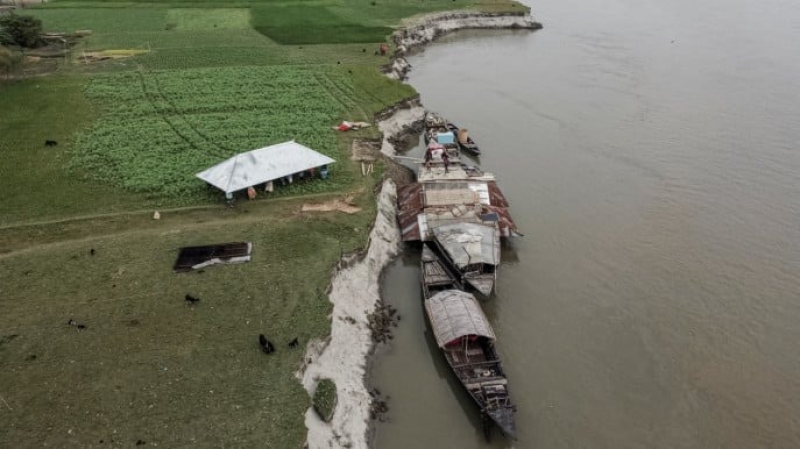- Rivers Keep Swallowing Land as Bangladesh Battles Erosion |
- UN Warns Refugees Caught in Climate–Conflict Cycle |
- Mohammadpur Sub-Jail in Magura lies abandoned |
- BD trade unions demand 10-point climate action ahead of COP30 |
- Bangladesh criticises Rajnath remarks on Yunus |
Rivers Keep Swallowing Land as Bangladesh Battles Erosion

A drone view shows people carrying the roof of the house belonging to Nurun Nabi, 30, who was forced to relocate to another island due to erosion caused by the Brahmaputra River, in Kurigram, Bangladesh on 29 October, 2025.
On an overcast morning in northern Bangladesh, Nurun Nabi loads bamboo poles and tin sheets onto a wooden boat. His home, built just a year ago on a fragile island in the Brahmaputra River, is once again threatened by rising waters.
It is the second time in a year that the 50-year-old farmer and father of four has had to relocate.
“The river is coming closer every day,” Nabi said, his voice tight with exhaustion. “We are born to suffer. Our struggle is never-ending. I’ve lost count of how many times the river took my home.”
His rice and lentil fields have already been claimed by the river, leaving him no choice but to move to another char — a temporary island formed by river sediment.
Every year, hundreds of families in Kurigram district face the same fate. As the Brahmaputra, Teesta, and Dharla rivers swallow land, people lose not only homes but also crops, livestock, and livelihoods. These shifting chars are among Bangladesh’s most fragile landscapes, where families rebuild again and again, only to see the river reclaim everything.
“The water comes without warning,” said 70-year-old farmer Habibur Rahman. “You go to sleep at night, and by dawn, the riverbank has moved. You wake up homeless. There is no peace in our life.”
Bangladesh’s struggle offers a stark warning for global leaders gathering at COP30 in Brazil. The country has long been praised for resilience — building embankments, improving flood forecasting, and pioneering community-based adaptation. Yet without stronger international support, these efforts may not be enough.
“People here are paying the price for emissions they never made,” said Ainun Nishat, a water resource and climate change specialist. “If COP30 means anything, it must deliver real funding to protect lives and land before it’s too late.”
Scientists point to accelerated Himalayan glacial melt as a key factor. Extra water flowing downstream combines with erratic monsoon patterns — intense, sudden rainfall followed by droughts — to worsen floods and erosion.
Kosim Uddin, a father of seven, has rebuilt his home more than 30 times. “Every time we rebuild, the river comes again,” he said. “But where can we go? The whole world is water now.”
Women and children face the brunt of repeated displacement. Shahina Begum, 30, has moved six times in a decade. “Every time we start again, the river takes it back,” she said. “Finding dry ground, cooking, and caring for children is even harder without privacy or safety.”
Some hope comes from local interventions. On Kheyar Alga Char, geobags — large sand-filled sacks — have helped 300 families stay put for three years by strengthening riverbanks. Raised villages are also being built to withstand seasonal floods.
“Maybe the river will come again one day,” said Johurul Islam, who lost his home more than ten times before settling here. “But for now, the land is holding — and so are we.”

